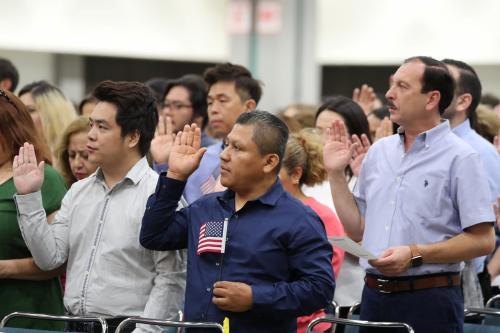As we approach the November election Americans are overwhelmed with the amount of campaign ads flooding their television and social media feeds. It is estimated that by election day over $9.7 billion will have been spent on campaign ads. Between January 6, 2021, and August 7, 2022, 2 million ads aired on national television alone.
The volume of campaign ads can unfortunately be harmful to some members of the public due to the heavy emphasis on immigration and immigrants.
While the United States has been home to an anti-immigrant political climate that has politicized Latino immigrants for several election cycles, it feels as though the volume of campaign ads that focus on border enforcement has increased this campaign season. America’s Voice has reported 700 unique paid ads that have been viewed 52.6 million times on voters’ social media feeds are anti-immigrant, divisive and/or racist. Many of these ads are generating fear and xenophobia by framing the immigration issue around an “invasion” of immigrants coming to the United States, which generates fear and anger.
The primaries push candidates to mobilize the more ideologically extreme segments of their respective parties. It is therefore not surprising there was a heavy use of border enforcement and anti-immigrant ads during the Republican primary. However, what is surprising is that the Southern border was used as the backdrop for campaign ads during the primary season in non-border states. This included ads suggesting weak borders were responsible for drugs and crime in states as far from the border as South Carolina and Alabama.
We are interested in how the exposure to a high number of anti-immigrant campaign ads may impact the attitudes of the Latino population.
Latino Exposure to Campaign Ads and Their Impact on Latino Families
We rely on the Abriendo Puertas/Unidos US National Latino Family Survey to get a sense of how pervasive exposure to anti-immigrant campaign advertising is among Latinos. The survey asked respondents if they have seen any campaign ads on television or online that they felt discriminated against or were intended to make the public think negatively of immigrants. Over a third (36 percent) of Latino parents or primary caregivers indicated they have seen these ads, with a higher percentage of registered voters reporting exposure.
The National Latino Family Survey asked respondents who have viewed these ads how this made them feel. As reflected in the figure below, the most commonly reported reaction among Latinos in the sample was “anger”. This was a particularly common response among foreign-born Latinos (+6 percent relative to their U.S.-born counterparts).
The next two most common reactions identified by respondents are “nervous/anxious” at 40 percent and “scared” at 27 percent. When combined these two outcomes that are often measures included in mental health studies, were mentioned by 67 percent of Latinos across the country. This is consistent with the literature documenting how the anti-immigrant politics across the country negatively impacts mental health of immigrants. The anti-immigrant sentiment was expanded by former President Trump and research has found that there is a link between Trump’s racist policies and symptoms of both depression and anxiety for Latinos.
I have found in my own work that living in states with punitive immigration policies does not only impact the health of immigrants, but Latinos overall. This helps explain why U.S.-born Latinos, who are not immigrants themselves, are more likely to report they are nervous or anxious upon seeing anti-immigrant campaign ads than immigrants in the sample (+7 percent for U.S.-born Latinos relative to the overall sample).
Another 29 percent of respondents indicated seeing these campaign ads made them feel as though “people do not want me here in the United States.” This is an important response to track, as the social science literature has found Latinos often report feelings of not belonging or feeling unvalued in society when exposed to discrimination.
Reflecting the variation in Latinos attitudes, 15 percent of the sample of Latino parents and primary caregivers said they felt the campaign ad they saw “was spot on with what needs to be done with immigration policy.”
Implications and Potential Solutions
The rise in these anti-immigrant ads is indicative of wider acceptance for this extreme political rhetoric, which unfortunately suggests the Latino community will continue to be exposed to more stress-inducing political images than ever. This is an issue we should all be concerned with given the impact these ads have on Latinos’ perception that they are welcome in this country. Feeling as though you belong and are valued in society has huge implications for civic engagement. Seeing evidence that exposure to anti-immigrant campaign ads influences sense of belonging is worrisome for those interested in civic participation of Latinos, regardless of which party they choose to support.
To circumvent millions of people being exposed to this, networks should be pressured to prohibit this type of hate and fearmongering to be aired.
A way to combat these harmful ads would be to prevent them from being viewed in the first place. To circumvent millions of people being exposed to this, networks should be pressured to prohibit this type of hate and fearmongering to be aired. Whether by filing a complaint through the Federal Communications Commission (FCC) to implement regulations, or creating social pressure for change, networks are responsible for what they choose to broadcast and should be held accountable.
The implications of a sharp increase in anti-immigrant campaign ads on the mental health of Latino Americans are huge given the limited access to mental health services the Latino population has experienced both before and during the pandemic. Latinos have greater delays in receiving mental health care (twice as likely as white Americans) and they are less likely to receive guideline care for depression and anxiety compared to white Americans. Expanding access to quality mental health services to a wider segment of the Latino community will help address longer-term challenges this community faces in regard to mental health.
The Brookings Institution is committed to quality, independence, and impact.
We are supported by a diverse array of funders. In line with our values and policies, each Brookings publication represents the sole views of its author(s).









Commentary
Anti-immigrant campaign ads negatively impact Latinos’ mental health and make them feel unwelcome in the United States
November 1, 2022